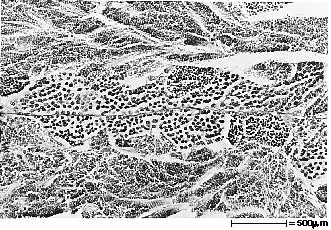Reconnaissance of 17ß-Estradiol, 11-Ketotestosterone, Vitellogenin,
and Gonad Histopathology in Common Carp of United States Streams:
Potential for Contaminant-Induced Endocrine Disruption
By Steven L. Goodbred, Robert J. Gilliom, Timothy S. Gross, Nancy P. Denslow,
Wade L. Bryant, and Trenton R. Schoeb
U.S. Geological Survey Open-File Report 96-627
Figures 2E-G
Figure 2E. Male adult carp testis from Platte River at Louisville, Nebraska,
showing thick germinal epithelium with diffuse pronounced proliferation and
maturation of spermatozoa; classified as stage 1, early spermatogenic. The
carp was 8 years old, 475 mm in length, and weighed 1,454 g.

Figure 2F. Male adult carp testis from Hudson River, south of Lake Luzerne,
New York, showing moderately thick germinal epithelium with diffuse moderate
proliferation and maturation of spermatozoa; classified as stage 2,
mid-spermatogenic. The carp was 2 years old, 518 mm in length, and weighed
2,334 g.

Figure 2G. Male adult carp testis from Anacostia River at Washington Shipping
Channel, District of Columbia, where germinal epithelium is mostly thin with
only scattered spermatogenic activity characteristic of full-grown testes;
classified as state 3, late spermatogenic. The carp was 5 years old, 530 mm
in length, and weighed 2,286 g.

Back to:
Methods


